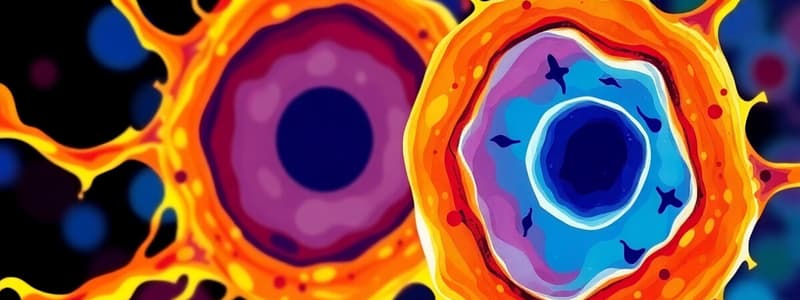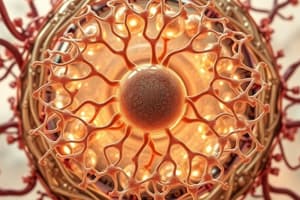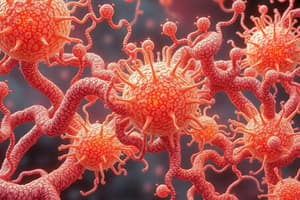Podcast
Questions and Answers
Which of the following is NOT a fundamental tenet of the cell theory?
Which of the following is NOT a fundamental tenet of the cell theory?
- Cells are the building blocks of all plants and animals.
- Cells can spontaneously generate from non-cellular material. (correct)
- Cells are the smallest units that perform all vital physiological functions.
- All cells arise from the division of pre-existing cells.
Totipotent stem cells can differentiate into any cell type, including embryonic and extraembryonic cells.
Totipotent stem cells can differentiate into any cell type, including embryonic and extraembryonic cells.
True (A)
What property distinguishes unipotent cells from non-stem cells, despite their ability to produce only one cell type?
What property distinguishes unipotent cells from non-stem cells, despite their ability to produce only one cell type?
self-renewal
The glycocalyx, formed by carbohydrate portions of glycolipids and glycoproteins, acts as molecular ______ that enable cells to recognize one another.
The glycocalyx, formed by carbohydrate portions of glycolipids and glycoproteins, acts as molecular ______ that enable cells to recognize one another.
Match the following cell junctions with their primary function:
Match the following cell junctions with their primary function:
Which component of the plasma membrane is responsible for maintaining fluidity by preventing tight packing at cold temperatures?
Which component of the plasma membrane is responsible for maintaining fluidity by preventing tight packing at cold temperatures?
Gram-positive bacteria have a thinner layer of peptidoglycan in their cell walls compared to Gram-negative bacteria.
Gram-positive bacteria have a thinner layer of peptidoglycan in their cell walls compared to Gram-negative bacteria.
What is the primary function of the nucleolus within the nucleus of a eukaryotic cell?
What is the primary function of the nucleolus within the nucleus of a eukaryotic cell?
Specialized cell surface projections containing inner core of microtubules that move fluids over a cell's surface or move an entire cell are called ______ and flagellum, respectively
Specialized cell surface projections containing inner core of microtubules that move fluids over a cell's surface or move an entire cell are called ______ and flagellum, respectively
Match each type of vesicular transport with its description:
Match each type of vesicular transport with its description:
Which of the following is a characteristic unique to eukaryotic cells but not prokaryotic cells?
Which of the following is a characteristic unique to eukaryotic cells but not prokaryotic cells?
Microfilaments and microtubules are stable, permanent structures within the cytoskeleton once assembled.
Microfilaments and microtubules are stable, permanent structures within the cytoskeleton once assembled.
What is the role of integrins within the plasma membrane?
What is the role of integrins within the plasma membrane?
The process of removing hydrogen from organic molecules including lipids, alcohol, and ingested substances, abundant in liver is known as ______.
The process of removing hydrogen from organic molecules including lipids, alcohol, and ingested substances, abundant in liver is known as ______.
Match each of the following endoplasmic reticulum types with its primary function:
Match each of the following endoplasmic reticulum types with its primary function:
Which of the following statements best describes the amphipathic nature of phospholipids in the plasma membrane?
Which of the following statements best describes the amphipathic nature of phospholipids in the plasma membrane?
All integral membrane proteins span the entire lipid bilayer.
All integral membrane proteins span the entire lipid bilayer.
What role do proteasomes play in maintaining cellular health?
What role do proteasomes play in maintaining cellular health?
The major site of ATP production in a cell, characterized by its double membrane structure and presence of cristae, is called the ______.
The major site of ATP production in a cell, characterized by its double membrane structure and presence of cristae, is called the ______.
Match each of the following transport mechanisms with its energy requirement:
Match each of the following transport mechanisms with its energy requirement:
Flashcards
What is the Cell Theory?
What is the Cell Theory?
All living things are composed of cells. Cells are the basic units of structure and function in living things. All cells are produced from other cells.
What are Stem Cells?
What are Stem Cells?
Undifferentiated biological cells that can differentiate into specialized cells and divide to produce more stem cells.
What are Prokaryotic Cells?
What are Prokaryotic Cells?
Cells lacking a nucleus or membrane-bound organelles.
What are Eukaryotic Cells?
What are Eukaryotic Cells?
Signup and view all the flashcards
What is the Plasma Membrane?
What is the Plasma Membrane?
Signup and view all the flashcards
What is the Cytoplasm?
What is the Cytoplasm?
Signup and view all the flashcards
What is the Nucleus?
What is the Nucleus?
Signup and view all the flashcards
What are the components of plasma membrane?
What are the components of plasma membrane?
Signup and view all the flashcards
What is facilitated diffusion?
What is facilitated diffusion?
Signup and view all the flashcards
What is the cytoskeleton?
What is the cytoskeleton?
Signup and view all the flashcards
What is a ribosome?
What is a ribosome?
Signup and view all the flashcards
What is the Golgi complex?
What is the Golgi complex?
Signup and view all the flashcards
What is a lysosome?
What is a lysosome?
Signup and view all the flashcards
What is the mitochondrion?
What is the mitochondrion?
Signup and view all the flashcards
What is the nucleus?
What is the nucleus?
Signup and view all the flashcards
Study Notes
- Here are the study notes
Cell Structure
- Cell theory describes cells as the building blocks of all plants and animals.
- All cells originate from pre-existing cells through division.
- Cells are the smallest units that carry out all vital physiological functions.
- Each cell maintains homeostasis at a cellular level.
- Stem cells are undifferentiated biological cells that differentiate into specialized cells and divide to produce more stem cells through mitosis.
- The body has many different kinds of cells.
- Human cells have about 200 different types, with approximately 20 different structures or organelles within them.
Types of Stem Cells
- Embryonic stem cells are isolated from the inner cell mass of blastocysts.
- Adult stem cells are found in various tissues.
- In adults, stem and progenitor cells serve as a repair system.
- In a developing embryo, stem cells differentiate into all specialized cells, including ectoderm, endoderm, and mesoderm (germ layers), which give rise to all body tissues and organs.
Stem Cell Potency
- Potency is the differentiation potential of a stem cell.
- Totipotent stem cells can differentiate into embryonic and extraembryonic cell types and construct a complete, viable organism; these cells are produced from the fusion of an egg and sperm cell.
- Pluripotent stem cells are descendants of totipotent cells and can differentiate into nearly all cells, derived from the three germ layers.
- Multipotent stem cells can differentiate into a number of cell types within a closely related family.
- Oligopotent stem cells can differentiate into only a few cell types, such as lymphoid or myeloid stem cells.
- Unipotent cells can produce only one cell type but have the property of self-renewal, distinguishing them from non-stem cells.
- Stem cell division can be symmetric or asymmetric, resulting in stem cells, progenitor cells, or differentiated cells.
- Potential uses of stem cells include treating stroke, traumatic brain injury, learning defects, Alzheimer's and Parkinson's diseases, baldness, blindness, deafness, and spinal cord injuries.
Cell Types
- Cells consist of a surrounding membrane, protoplasm (cell contents in thick fluid), and organelles (structures for cell function), controlled by DNA.
- Prokaryotic cells lack a nucleus or membrane-bound organelles and are the simplest type of cells.
- Gram-positive bacteria have a thick cell wall made of peptidoglycan.
- Gram-negative bacteria have a thinner layer of peptidoglycan.
- Eukaryotic cells possess a membrane-bound nucleus and compartmentalize cellular functions within organelles.
- The three main parts are plasma membrane, cytoplasm (cytosol + organelles), and nucleus.
Plasma Membrane
- Is a phospholipid bilayer with cholesterol, attached carbohydrates (glycolipids and glycoproteins), and proteins (integral and peripheral).
- Consists of amphipathic phospholipids with hydrophobic fatty acid tails and hydrophilic phosphate group heads.
- Functions include acting as a barrier, controlling entry of materials, receiving chemical and mechanical signals, and transmitting signals between intra- and extra-cellular spaces.
- The polar regions of phospholipids are oriented toward the surfaces of the membrane due to their attraction to the polar water molecules in the extracellular fluid and cytosol.
- Proteins can be integral proteins (closely associated with the membrane lipids) or peripheral proteins (located at the membrane surface)
- There are a variety of membrane functions achieved via anchored proteins:
- Anchoring
- Recognition
- Enzymes
- Channels
- Receptors
- Carriers
Cell Junctions
- Include desmosomes (anchoring proteins), tight junctions (sealing membranes), and gap junctions (protein channels).
- They hold adjacent cells firmly together in areas of stretching (desmosomes), they prevent extra cellular leakage (tight) and are a method of communication between cells (gap).
Cytoplasm
- Consists of a fluid portion (cytosol) and organelles.
- Organelles include the endoplasmic reticulum (ER), Golgi complex, lysosomes, peroxisomes, proteasomes, and mitochondria.
- The non membranous organelles are:
- Cytoskeleton
- Microvilli
- Centrioles
- Cilia
- Flagella
- Ribosomes
- The membranous organelles are:
- Mitochondria
- Nucleus
- Endoplasmic Reticulum
- Golgi Apparatus
- Lysosomes
- Peroxisomes
Cytoskeleton
- Maintains shape of cell, positions organelles, and changes cell shape, includes microfilaments, intermediate filaments, and microtubules.
- The centrosome is composed of two centrioles arranged perpendicularly, composed of microtubules and Pericentriolar material Function: moves chromosomes to ends of cell during cell division
Endoplasmic Reticulum
- A network and folded membranes with rough ER (studded with ribosomes; sites of protein synthesis) and smooth ER (lacks ribosomes; functions in lipid synthesis, glucose release, drug detoxification).
Golgi Complex
- Flattened membranes modify proteins into glycoproteins and lipoproteins.
- They can become parts of plasma membranes, can be stored in lysosomes, or are exported by exocytosis.
Lysosomes
- Spherical or oval structures that contain digestive enzymes.
- Help in final processes of digestion within cells, carry out autophagy, and eliminate of worn-out cells.
Mitochondria
- Major site of ATP production and CO2 formation.
- Have some DNA and ribosomes.
- Abundant in muscle, liver, and kidney cells.
Nucleus
- Round or oval structure surrounded by nuclear envelope with nuclear pores.
- Contains nucleolus, makes ribosomes that pass into cytoplasm through nuclear pores.
- DNA, associated with proteins, threads known as chromatin.
Transport Across Membranes
Cellular Process
- Passive Transport happens when no energy is used, with kinetic Energy and both solutes, solvents diffuse.
- Osmosis is how the solvent diffuses through a semi-permeable route from low to high gradients
- Simple Diffusion
- solute diffuses from High -> Low
- Down to its gradient
- Happens through the lipid bilayer
- Facilitated Diffusion -Ion channel gated by channel proteins -The route is Ligand, Voltage or Mechanically gated
Active transport
- Primary: when ATP directly used → activate PUMP= Pressure and a Charge Gradient
- Energy required = against concentration gradient = via pump = can be saturated
Secondary
-
Use electrochemical gradient made by Primary active transport =
-
Specific ion channel, carriers for specific particles and Ions channel's saturation. Vesicular transport (macromolecule)
-
The route is Transporters that bind to carrier protein, pass through Big polar molecule (unionised) glucose, fructose, galactose, vitamins with saturation There are two methods
-
Transcytosis
-
Endocytosis
-
Exocytosis
Studying That Suits You
Use AI to generate personalized quizzes and flashcards to suit your learning preferences.





